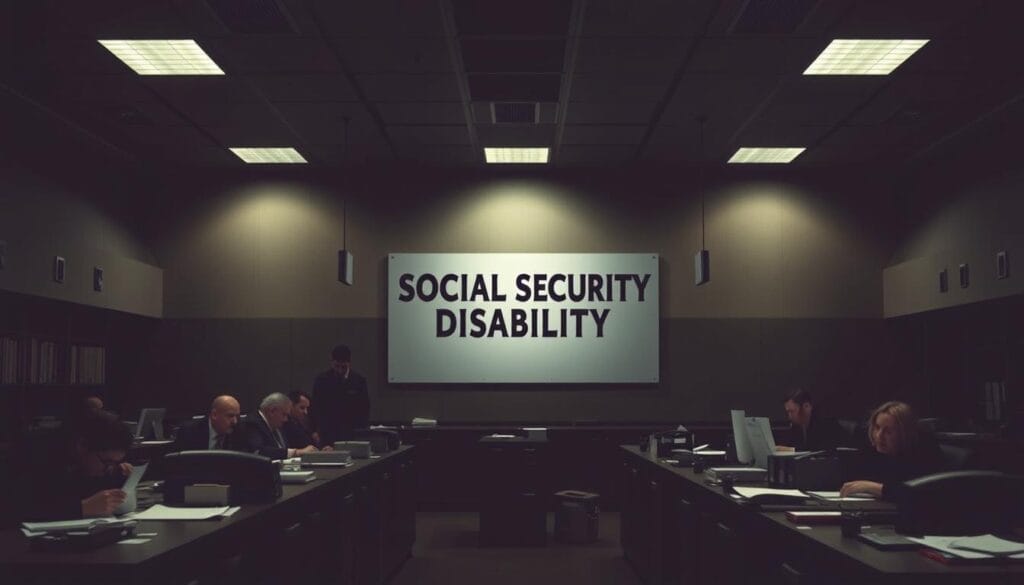Disability Qualification Rules Tightened Under Trump.

Disability Qualification Rules Tightened: The Trump administration is tightening the rules for Social Security disability qualifications. They want to determine if older Americans can find new employment opportunities. This could change how SSDI and SSI are given out.
Currently, the Social Security Administration considers age, work history, and education as factors in determining eligibility. People over 50 have had an easier time getting approved because of their age. But the new rules aim to update job data and consider more job options.
The SSA is working with the Bureau of Labor Statistics to update job lists. This change could make it harder for people to get approved. It’s estimated that hundreds of thousands could lose their benefits. For more information, see this report on projected eligibility cuts.
Some people think the new rules are a good idea because work has changed. Others, like Senator Ron Wyden, disagree. The SSA plans to ask for public comments before making any final decisions.
This change could impact many individuals, including older workers and their families. The Urban Institute says it could lead to more people retiring early. This makes the debate over these new rules very important.
Key Takeaways
- SSDI and SSI updates under consideration could remove age as a factor or raise the threshold to 60.
- Modernized job data would replace outdated roles, reshaping how the ability to work is assessed.
- Analysts project large declines in approvals, with a significant impact on older Americans.
- Some denied applicants may opt for early retirement, but they will face permanent benefit reductions.
- The SSA states that the proposed rules will undergo public notice and comment before finalization.
- Further coverage of updated disability regulations under Trump appears in national debate reporting and broader budget discussions at federal budget policy outlets.
Trump Administration Disability Rules: What’s Changing and Who Is Affected
The Trump administration is changing how Social Security decides who can work. These changes affect age, job skills, and education. People are watching to see who will face tougher reviews and how many will be denied.
Shift in how age, work experience, and education are weighed
Now, Social Security considers age, work history, and education to determine if someone can change jobs. People over 50 often get more help because it’s harder to find new work as you get older.
But the Trump administration wants to change this. They think older people might not get as much help finding new jobs. This is part of a bigger plan to change disability benefits.
Potential elimination of age as a factor or raising the threshold to 60
There’s talk about removing age from the decision-making process. Or, raising the age to 60. This could make it more difficult for people in their 50s to access help.
Experts say this could lead to more people choosing to retire early. They might take smaller checks than they would get from disability benefits. For more information, see the national overview of proposed cuts.
Modernizing job data used to assess the ability to work
For a long time, Social Security used an old job list. Now, they want to use modern labor data. They plan to create a computer database of jobs.
Supporters say this will make decisions more relevant today. Critics worry it could make it harder to get benefits. This comes as the system is already facing delays and failures, as reported in recent articles.
Impact on older Americans, widows, and children
Experts think a 10 percent reduction in eligibility could affect hundreds of thousands. Up to 400,000 people might get smaller SSI payments. About 80,000 widows and children could lose support because of a disabled spouse or parent.
In Connecticut, thousands could be affected if SSI cuts are implemented. The Trump administration’s rules could change the financial future for older workers and families across the country.
| Change Area | What’s Proposed | Who Feels It Most | Notable Figures | Why It Matters |
|---|---|---|---|---|
| Age in Vocational Decisions | Remove age or raise the threshold to 60 | Applicants 50–59 | 42% of approvals tied to vocational factors in 2022 | Weakens age-based advantage, affecting approvals |
| Job Data Modernization | New computer-generated database using BLS data | Claimants with outdated skills | Outdated roles like “nut sorter” cited in past decisions | More “viable” job matches may increase denials |
| SSI Payment Rules | Tighter rules for those living with others on aid | Low-income households | Up to 400,000 may face reduced checks | Cuts compound financial stress for families |
| Overall Eligibility | Stricter vocational framework | Older workers, widows, and children | 10% reduction could mean 750,000 fewer beneficiaries | Large-scale shift in access to disability support |
Disability Qualification Rules Tightened Under Trump
Under Trump, the rules for getting disability benefits have changed. Now, age plays a more significant role in decision-making. Additionally, the focus is on whether you can pursue alternative careers based on your current job.
The Social Security Administration aims to improve and make the system fairer. They plan to update the rules through a public input process. This way, everyone can share their thoughts.
For people between 50 and 59, receiving benefits may be more challenging. This is because age is now a bigger factor. Advocates are watching closely as older people face tougher tests.
At the same time, the rules for SSI are being updated. This is to match today’s jobs and keep the trust funds safe.
There’s a shift in the job market, with an increase in office-based and flexible job opportunities. This could help some people with disabilities, but make it harder for others. Early signs show fewer approvals and more denials than before.
Reports on these changes are getting attention. Readers are learning about the impact on families.
Not everyone agrees with these changes. Senator Ron Wyden thinks they could hurt older Americans and their families. But the agency leaders say they are making things more transparent and fairer.
As the debate continues, it’s essential to keep the bigger picture in mind. The Trump presidency has set the stage for these policies.
| Policy Focus | What Changes | Who Feels It Most | Key Rationale |
|---|---|---|---|
| Age in Adjudication | Possible removal or shift of age thresholds | Applicants 50–59 | Consistency and integrity in decisions |
| Job Data Modernization | Use of updated occupational databases | All claimants assessed for alternative work | Reflect current labor market tasks and skills |
| Program Administration | Faster reviews and clearer vocational rules | State disability offices and applicants | Efficiency and protection of trust funds |
| SSDI and SSI Criteria | Refined standards and SSI eligibility criteria updates | Older workers and families | Align with news on SSDI eligibility criteria revised |
| Policy Direction | Emphasis on work capacity where possible | Mixed outcomes across impairments | Trump’s policy changes on disability qualifications prioritize modern work realities |
Social Security Disability Changes: SSDI and SSI Eligibility Criteria Revised
The Social Security Administration is implementing significant changes to the eligibility criteria for disability benefits. These changes are because of Trump’s policies. They could change who gets benefits and how long it takes to get them.
Key context: 8.4 million workers rely on disability benefits. Policy proposals aim to reduce costs by modifying the distribution of benefits. This could impact who receives benefits and the duration of the process.

How SSA currently evaluates disability claims and why older applicants fare better
SSA has a five-step process to check if someone is disabled. It examines current work, severe impairments, and an individual’s ability to perform their job. If someone can’t meet a specific job requirement, their age, education, and work history are taken into consideration.
Older applicants often get approved because they may not be able to change careers easily. This makes it easier for them to obtain benefits when medical evidence alone is insufficient.
Replacing outdated occupations with a computer-generated database of modern jobs
For a long time, the system had been using an outdated job list. Now, SSA is using a new database from the Bureau of Labor Statistics. This helps match claims to real jobs today.
With this new system, a computer will suggest jobs that match a person’s skills and abilities. Some worry that this could make it harder to obtain benefits, as age may not matter as much.
Projected outcomes: fewer approvals, increased early retirements, and reduced lifetime benefits
Research indicates that making it more difficult to obtain benefits can reduce the number of people who receive them. When more people are denied, some choose to retire early. This means they get smaller checks than they would have from SSDI.
SSA data indicate that approvals are decreasing annually. With more reviews and new job matching, fewer people might get benefits. This could lead to more early retirements, which would impact families’ financial stability.
Political and policy perspectives are shaping the updated disability regulations under the Trump administration.
There are different views on these changes. Some want to make it harder to get benefits, while others think there are more jobs available. Senator Ron Wyden and SSA’s Barton Mackey want to make sure everyone has a say in these changes.
Changes in other support programs also matter. Lawmakers are considering significant cuts to Medicaid and SNAP. These could affect people with disabilities, as seen in reports on safety-net cuts.
| Policy Area | What Changes | Expected Direction | Who Is Most Affected | Budget Impact (10 Years) | Retroactive SSDI Pay |
|---|---|---|---|---|---|
| Reduce the back pay window from 12 to 6 months | Lower lump-sum awards | New SSDI awardees | About $10B savings | ||
| Continuing Disability Reviews | |||||
| “Medical improvement likely” category every 2 years | More frequent rechecks | Current SSDI recipients | $2B savings; $1.8B admin costs | ||
| Occupational Data | |||||
| Computer-generated BLS database replaces obsolete job list | Broader job matches | Applicants near vocational thresholds | Fewer approvals projected | ||
| Age and Vocational Rules | |||||
| Potentially less weight on age in job adjustments | Harder to qualify via grids | Workers 50–59 | Lower lifetime benefits for early retirees | ||
| Overall SSDI Outlays | |||||
| Multiple rule changes across eligibility and reviews | Tighter gatekeeping | Applicants and recipients | Up to $26B reduction |
These changes demonstrate the impact of Trump’s policies on disability benefits. They involve new rules for job descriptions and performance reviews. These changes could impact older workers, caregivers, and children across the U.S.
Disability Qualification Rules Tightened Conclusion
The rules for obtaining disability benefits have changed under the Trump administration. Now, age is less important, and new job data is used to see what people can do. This could make it more difficult for individuals, such as those in their 50s, to access benefits.
Experts believe this could impact a significant number of people. If fewer people receive benefits, 750,000 could lose out over the next 10 years. This includes 80,000 widows and children who depend on these benefits. It could also mean less money for many families.
Some people think these changes are good because they make the system fairer. Others worry that more people will be denied benefits. This could hurt those who need help the most.
These changes will affect many families across the country. The Social Security Administration will listen to public comments and may face court challenges. To stay updated on these changes, follow the latest news on Social Security Administration cuts.
Disability Qualification Rules Tightened FAQ
What does “Disability Qualification Rules Tightened Under Trump” actually mean?
This refers to a plan by the Trump administration. It aims to make it more difficult for some, such as those in their 50s, to qualify for Social Security Disability Insurance (SSDI). It also indirectly affects Supplemental Security Income (SSI). The plan would reduce the role of age in determining benefits and utilize modern job data to assess whether applicants can perform other work.
How does SSA currently weigh age, work experience, and education?
SSA considers age, education, and past work experience to determine if an individual is capable of performing other types of work. People aged 50 and older often receive a boost because age is usually seen as a barrier to retraining. In 2022, these rules enabled approximately 42 percent of approvals.
What changes are being considered for age in disability decisions?
Officials are thinking about two options. They might remove age as a factor or raise the favorable age threshold to 60. Either change would make it harder for people in their early to mid-50s to qualify for SSDI under vocational guidelines.
Why is SSA updating the job data it uses to assess the ability to work?
The current list of jobs is outdated and includes positions such as a nut sorter and a telephone quotation clerk. SSA is funding the Bureau of Labor Statistics with over $100 million. They are building a modern database of 21st-century jobs to help match job seekers with potential employment opportunities.
Who would be most affected by the proposed disability rules?
Older applicants in their 50s, widows and children tied to a worker’s benefits, and SSI recipients living with others who receive public assistance could be most affected. Analysts warn that many older applicants who were denied may opt for early retirement at 62 and face a permanent reduction in their monthly benefits.
How many people could lose disability benefits if eligibility is tightened?
Urban Institute senior fellow Jack Smalligan estimates that a 10 percent eligibility reduction could result in approximately 750,000 fewer SSDI beneficiaries over a decade. This would also mean 80,000 fewer widows and children receiving linked benefits, with roughly a billion less in payments.
Will older Americans denied SSDI likely return to work?
Research cited by Smalligan suggests that most older Americans denied disability do not return to work. Many would likely claim Social Security retirement at 62, locking in about a 30 percent lifetime reduction in monthly benefits compared with SSDI.
What is the status of the new occupational database and algorithm?
SSA says it will use BLS data to build a computer-generated jobs database starting next year. Advocates worry it could identify many “available” jobs—especially if age is discounted—leading to higher denial rates. SSA emphasizes it will follow public notice and comment before finalizing rules.
How do these changes relate to SSDI versus SSI?
SSDI is an insurance benefit based on an individual’s work history; SSI is a needs-based benefit. While age and job data updates affect SSDI vocational decisions, SSA is also moving to rescind a Biden-era SSI rule that expanded eligibility for people living with others on SNAP or other aid, which could reduce payments for about 400,000 people.
Are these disability qualification changes already in effect?
No. SSA spokesperson Barton Mackey says proposals are being developed to improve adjudication, update job data, and optimize its use, with a commitment to public notice and comment before any rule is finalized.
What is the political response to tightening disability qualifications?
Reactions are polarized. OMB director Russell Vought prioritized the effort, and former SSA official Mark Warshawsky argues modern work expands options for disabled workers. Senator Ron Wyden calls the plan the most significant cut to disability insurance in history and says beneficiaries deserve fair access to what they paid into.
How do current trends in disability applications and approvals look?
Applications are down roughly 7 percent year over year. Initial denials have increased, and the SSA approved nearly 3 percent fewer claims compared to the prior year, according to an Urban Institute analysis.
Why do older applicants typically fare better under current rules?
The vocational grid presumes older workers have more difficulty retraining and adapting to new jobs. That presumption often tips borderline cases toward approval for those 50 and older, especially when combined with limited education or highly physical past work.
How could replacing outdated job titles change outcomes?
Using current BLS data may reveal more desk-based or flexible roles that are suitable for some applicants. If age carries less weight, adjudicators might find more “available” jobs, resulting in fewer approvals for older claimants.
What are the projected outcomes if the rules tighten?
Expect fewer approvals, more early retirements at 62, and reduced lifetime benefits for those denied SSDI. The Urban Institute’s modeling points to sizable declines in beneficiaries and payouts if eligibility drops by 10 percent.
What arguments do proponents and critics make about the updated disability regulations under Trump?
Proponents say the labor market has shifted toward more office-based and flexible roles, so guidelines should reflect today’s jobs and protect program integrity. Critics warn that the changes—especially algorithmic job matching and minimizing age—could deny benefits to tens of thousands of people each year and weaken the safety net.
How would rescinding the Biden-era SSI rule affect households?
Rolling back the expansion for people living with relatives or roommates who receive public assistance could trim payments for about 400,000 SSI recipients. Attorney Michelle Spadafore cautions that even modest cuts can destabilize tight household budgets.
Where can the public weigh in on the proposed Social Security disability changes?
The SSA states that any rule changes will undergo the formal rulemaking process, which includes public notice and a comment period. This allows individuals, advocates, and experts to submit feedback before rules are finalized.






